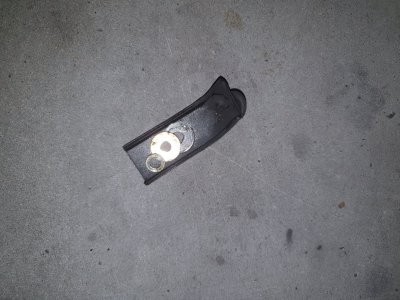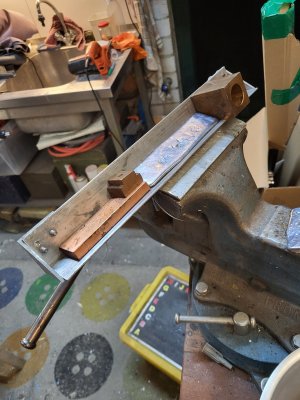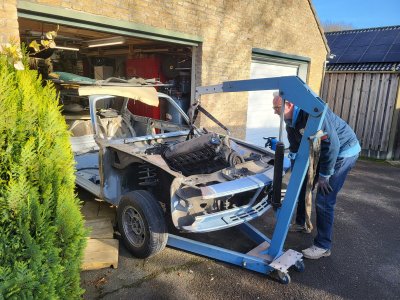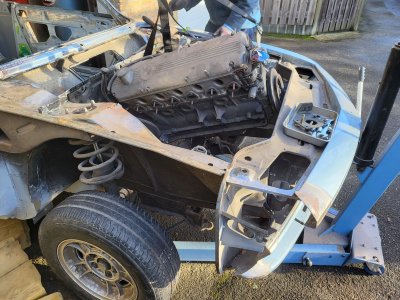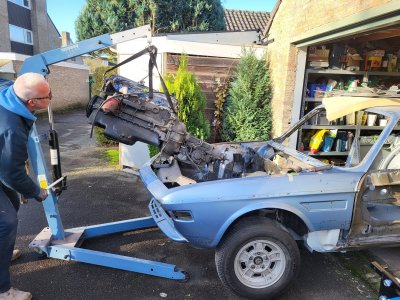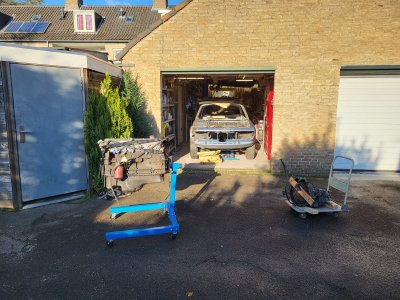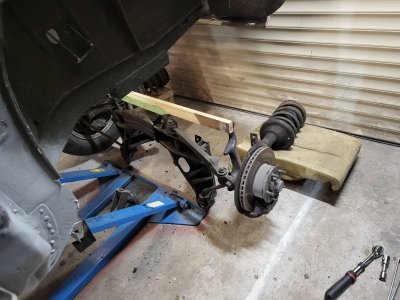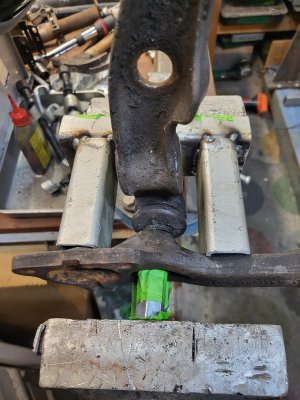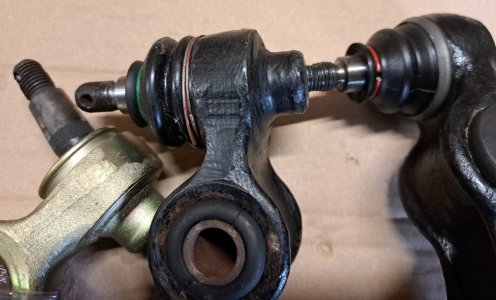@Breiti : yes there were!Yes,b talking about the welding spots from there dir skin.
But there should be 2 spots?
Breiti
You are using an out of date browser. It may not display this or other websites correctly.
You should upgrade or use an alternative browser.
You should upgrade or use an alternative browser.
Fixing that little rust spot...
- Thread starter eriknetherlands
- Start date
-
- Tags
- restoration list
wow you realy spend time to restore even the bolts and nuts is tagged, it look like it will be nice restoration, not like me all day looking for bolts and nuts I should of do it like you did and I have very bad memoryOver the past weeks I removed the internals from the right door, and pulled the skin off. The outer skin bottom part was spliced before by a PO, but it started rusting again. Also the underlying door structure had some rust spot on the top and bottom edge, so I patched in some 6 fresh pieces of steel.
While taking the skin off, i carefully marked where it was pinch welded, as I'd like to reproduce these welds again (though i do not know yet how too, as my spot welder will leave marks on the front of the door skin !) I slowly grinded the folded edge off until i saw the separate layers.
Dismanteling:
View attachment 176046 View attachment 176048 View attachment 176050
Some structure to know which bolts need to go back where: a simple drawing with holes
View attachment 176045
Doorskin with older patch panel; it had rust issues & needed being peeled off:
View attachment 176051 View attachment 176052View attachment 176053 View attachment 176055 View attachment 176054
some rusty bits underneath:
View attachment 176064 View attachment 176065 View attachment 176067
Today I decided to see if I could make another part; the lead weight that is clamped to the inside of the door handle. I had one missing. Buying it somewhere and waiting for it takes too long...
Used some old roofing lead, a piece of angled aluminum, an old stainless pan and the wife away for an evening, I think I got the main shape right.
I did use a fresh air filter mask, lead is very harmful when inhaled.
First pic is the original part from the other door (with some felt backing).
I first purified the lead by melting it, and letting it drip down to the side; the debris and corroded film float (lead is heavy and pushes everything up), so that stays behind.
Then it is into the kitchen to heat it up and pour it in a mold.
The shape is actually pretty easy; a piece of 90 degree aluminum with to copper blocks to define the length. When setting the Alu profile at the correct angle, it makes one beautiful ingot.
Now all it needs is some shaping to get the size right.
What I show you isattempt 4...Edit attempt 5; ingot#4 was too thick, and it would have taken too long to shave it to it correct thickness. Recasting #4 into #5 took just ten minutes.
Used some old roofing lead, a piece of angled aluminum, an old stainless pan and the wife away for an evening, I think I got the main shape right.
I did use a fresh air filter mask, lead is very harmful when inhaled.
First pic is the original part from the other door (with some felt backing).
I first purified the lead by melting it, and letting it drip down to the side; the debris and corroded film float (lead is heavy and pushes everything up), so that stays behind.
Then it is into the kitchen to heat it up and pour it in a mold.
The shape is actually pretty easy; a piece of 90 degree aluminum with to copper blocks to define the length. When setting the Alu profile at the correct angle, it makes one beautiful ingot.
Now all it needs is some shaping to get the size right.
What I show you is
Attachments
Last edited:
Recast attempt 4 into #5, and finished the part by shaving it with a sharp chisel (works wonderfuly well!) and drilling the two holes.
Last pic shows the original next to the new part.
Edit- added a pic after sanding it nicely flat on a belt sander.
I modified the original part with 4 small screws to reattach the lead weight after I rezinced the door handle mechanism. This should also prevent it from falling off ever again. In hind sight; 4 screws is a bit much, 2 would have been good enough




Last pic shows the original next to the new part.
Edit- added a pic after sanding it nicely flat on a belt sander.
I modified the original part with 4 small screws to reattach the lead weight after I rezinced the door handle mechanism. This should also prevent it from falling off ever again. In hind sight; 4 screws is a bit much, 2 would have been good enough
Last edited:
Today, after long procrastination, my neighbour helped me out to wrestle the engine+auto trans from the car. We have a leveller, but then the block wouldn't lift up high enough with it installed. So we just used straps.
It did scrape the engine bay in a few places, but no dents luckily. It gets repainted, so no worries there.
Not sure yet how we'll get it back in, as it'll be painted by then. Maybe i'll try the " drop the car over the engine " method.
It did scrape the engine bay in a few places, but no dents luckily. It gets repainted, so no worries there.
Not sure yet how we'll get it back in, as it'll be painted by then. Maybe i'll try the " drop the car over the engine " method.
Attachments
Question to the group - after lifting the engine, I've disassembled my steering system and front axle.
To dissassemble the whishbone from the track lever, I first tried to pop it out with one of those ball joint presses: No go.
Then i tried to heat the track lever with a gas burner. No go again.. But in doing so, I fried the skin of the rubber boot on the ball joint of the whishbone. The rubber boot still holds it's grease, but I'm rebuilding for it to be OK for >10 years.
In the end i build a jig to hold the whishbone and tracklever, and pressed it out with my very large vice. That worked easy-peasy.
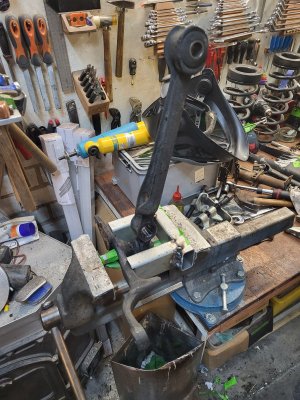
Now the whishbone is original BMW, and the ball joint is rotating smoothly, so I'd like to keep it, and only replace the fried rubber boot. And not spend 2X150 euro at Walloth for a Repro part just for an intact rubber boot.
Does anyone know if such rubber ball joint boot from another (BMW?) model would fit on the whishbone?

To dissassemble the whishbone from the track lever, I first tried to pop it out with one of those ball joint presses: No go.
Then i tried to heat the track lever with a gas burner. No go again.. But in doing so, I fried the skin of the rubber boot on the ball joint of the whishbone. The rubber boot still holds it's grease, but I'm rebuilding for it to be OK for >10 years.
In the end i build a jig to hold the whishbone and tracklever, and pressed it out with my very large vice. That worked easy-peasy.

Now the whishbone is original BMW, and the ball joint is rotating smoothly, so I'd like to keep it, and only replace the fried rubber boot. And not spend 2X150 euro at Walloth for a Repro part just for an intact rubber boot.
Does anyone know if such rubber ball joint boot from another (BMW?) model would fit on the whishbone?

Attachments
Last edited:
I recently had the same problem in separating the wishbones and track rods and I also ruined the rubber boots. My research was not comprehensive, but I was told these rubber parts are not available separately. Because I also damaged the tapered joints I didn't investigate the rubber question very thoroughly and decided to change the whole rod/arm. I know this doesn't answer your question, but I thought I'd share my experience as far as it goes.
If you will find any suitable - let me know. 
 polgum.sklep.pl
polgum.sklep.pl
Osłony gumowe harmonijkowe, mieszkowe, manszety do maszyn - POL-GUM
Osłony, mieszki gumowe ✅ Najwyższej jakości produkty z gumy ✅ Idealne do różnych zastosowań ✅ Sprawdź naszą ofertę teraz!
Hello Erik,Does anyone know if such rubber baal joint boot from another (BMW?) model would fit on the whishbone?
I went through this same exercise and searched high and low for a boot that would fit. I really wanted to re-use the original wishbones as well - the replacements probably work just fine but they do not look the same. I did find suitable boots!!! I don't remember the source, but I will look through what I have to see if I can find it. Here are photos of the new boots installed on my cleaned and repainted original wishbones.
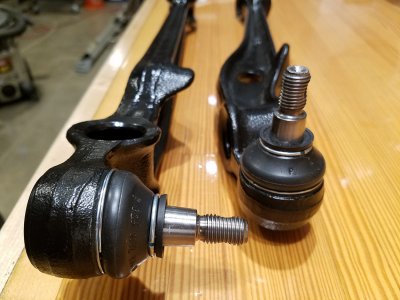
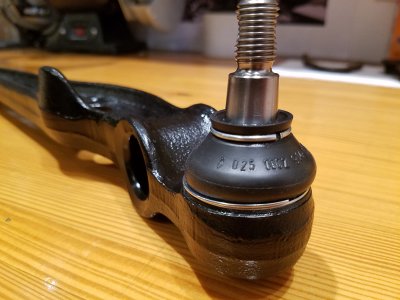
Here is an original wishbone compared to a repop one from OCAP:
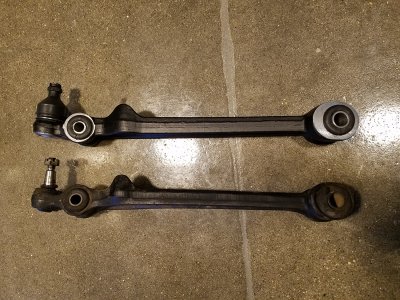
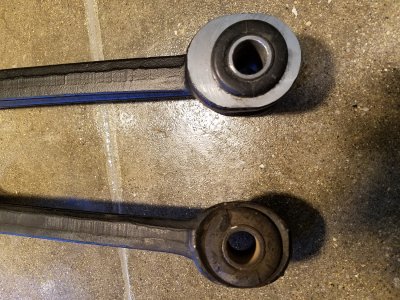
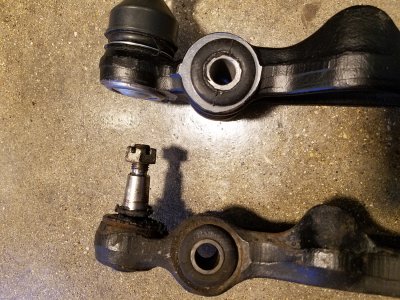
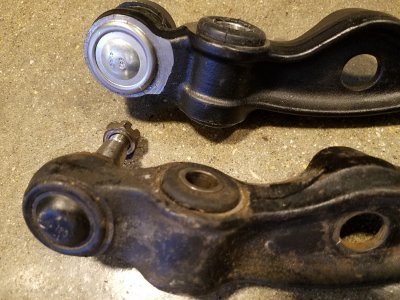
Energy Suspension, and likely others, make beefy black PU boots. They do not look like exactly like original (no retaining rings) but they seem to work well.
Amazon and others sell "generic" rubber boot sets. Have also seen silicone ones advertised.



Amazon and others sell "generic" rubber boot sets. Have also seen silicone ones advertised.
that's looking just how i'd want mine to come out.Hello Erik,
I went through this same exercise and searched high and low for a boot that would fit. I really wanted to re-use the original wishbones as well - the replacements probably work just fine but they do not look the same. I did find suitable boots!!! I don't remember the source, but I will look through what I have to see if I can find it. Here are photos of the new boots installed on my cleaned and repainted original wishbones.
View attachment 195811View attachment 195812
....
Great, I'm standing by ....
update: with the info above i went to my local generic parts store, and they simply turned up a box of unnamed, various sizes of these boots, and surely with a caliper out, we found a matching one. No brand or type designation, so I can't make the next forum member searchgin for it happy with that info, sorry!
edit: i found this brand "ruville", (pic from Jaymic website), they are a German spare parts manufacturing plant, but no google hits towards a specific E9 part.

edit: i found this brand "ruville", (pic from Jaymic website), they are a German spare parts manufacturing plant, but no google hits towards a specific E9 part.
Last edited:
Digging into my coupe, I removed the front right fender and yesterday i dug one lever deeper. Found this underneath, thought it was funny enough to share.
What's wrong with it (apart from the obvious age related rust)?


What's wrong with it (apart from the obvious age related rust)?
day66
Well-Known Member
I believe it is actually the part for the other side, so the reinforcing lips face to the centre of the car, not outwards .. but at least as it was replaced it should have helped keep the strut tower in position.

